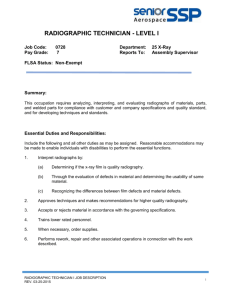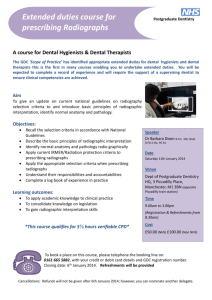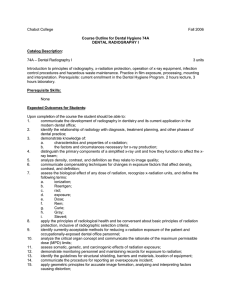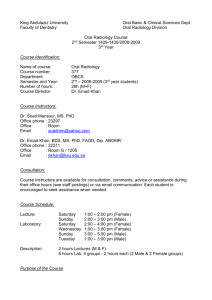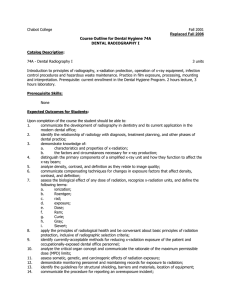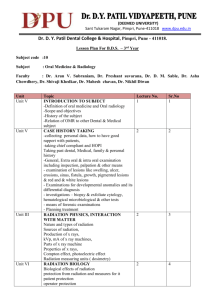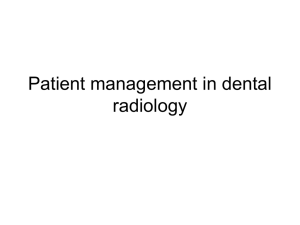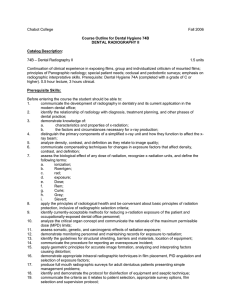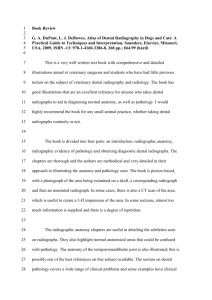Chabot College Fall 2007 74A - Dental Radiography I
advertisement
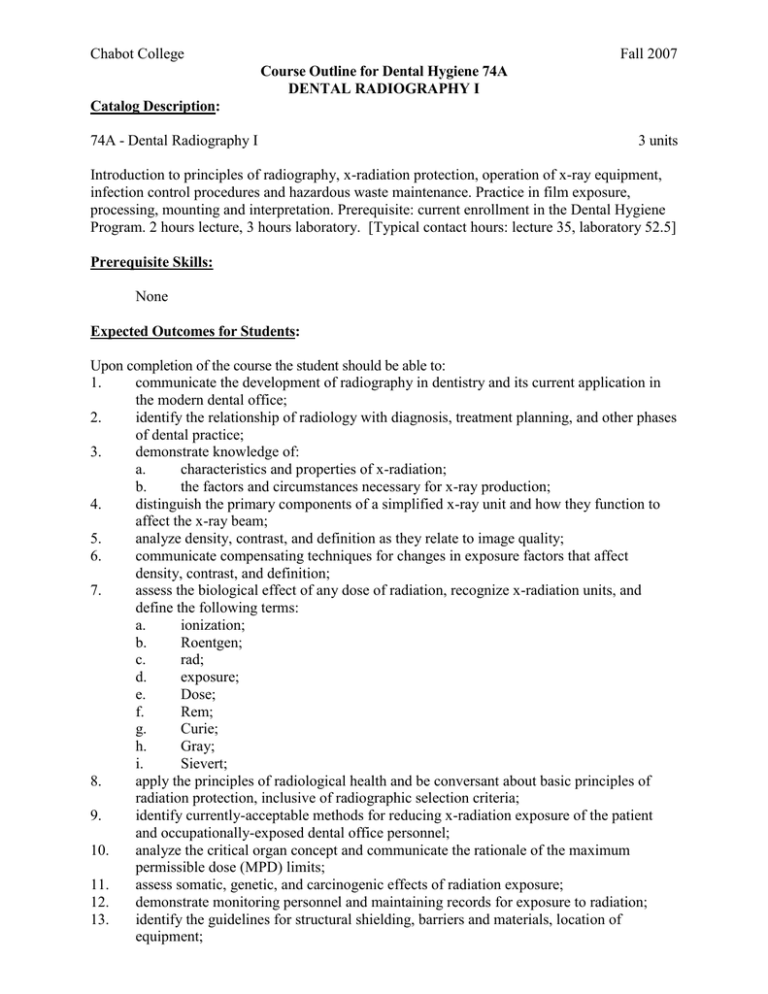
Chabot College Fall 2007 Course Outline for Dental Hygiene 74A DENTAL RADIOGRAPHY I Catalog Description: 74A - Dental Radiography I 3 units Introduction to principles of radiography, x-radiation protection, operation of x-ray equipment, infection control procedures and hazardous waste maintenance. Practice in film exposure, processing, mounting and interpretation. Prerequisite: current enrollment in the Dental Hygiene Program. 2 hours lecture, 3 hours laboratory. [Typical contact hours: lecture 35, laboratory 52.5] Prerequisite Skills: None Expected Outcomes for Students: Upon completion of the course the student should be able to: 1. communicate the development of radiography in dentistry and its current application in the modern dental office; 2. identify the relationship of radiology with diagnosis, treatment planning, and other phases of dental practice; 3. demonstrate knowledge of: a. characteristics and properties of x-radiation; b. the factors and circumstances necessary for x-ray production; 4. distinguish the primary components of a simplified x-ray unit and how they function to affect the x-ray beam; 5. analyze density, contrast, and definition as they relate to image quality; 6. communicate compensating techniques for changes in exposure factors that affect density, contrast, and definition; 7. assess the biological effect of any dose of radiation, recognize x-radiation units, and define the following terms: a. ionization; b. Roentgen; c. rad; d. exposure; e. Dose; f. Rem; g. Curie; h. Gray; i. Sievert; 8. apply the principles of radiological health and be conversant about basic principles of radiation protection, inclusive of radiographic selection criteria; 9. identify currently-acceptable methods for reducing x-radiation exposure of the patient and occupationally-exposed dental office personnel; 10. analyze the critical organ concept and communicate the rationale of the maximum permissible dose (MPD) limits; 11. assess somatic, genetic, and carcinogenic effects of radiation exposure; 12. demonstrate monitoring personnel and maintaining records for exposure to radiation; 13. identify the guidelines for structural shielding, barriers and materials, location of equipment; Chabot College Course Outline for Dental Hygiene 74A, Page 2 Fall 2007 Expected Outcomes for Students (continued): 14. 15. 16. 17. 18. 19. 20. 21. 22. 23. 24. 25. 26. 27. 28. 29. 30. 31. 32. 33. 34. 35. 36. 37. 38. 39. 40. 41. 42. 43. communicate the procedure for reporting an overexposure incident; apply geometric principles for accurate image formation, analyzing and interpreting factors causing distortion; demonstrate appropriate intraoral radiographic techniques in film placement, PID angulation and selection of exposure factors; produce full mouth radiographic surveys for adult dentulous patients presenting simple management problems; identify and demonstrate the protocol for disinfection of equipment and aseptic technique; communicate the criteria as it relates to patient selection, appropriate survey options, film selection and supervision protocol; analyze and compare interproximal and periapical surveys as they relate to: a. purpose and scope of examination; b. intraoral techniques; parallel vs. bisecting angle; properly mount and label all radiographs; evaluate all radiographs in terms of technical quality, accuracy and clinical acceptability; evaluate all radiographic errors (technical and processing) and describe the best methods for correcting them; identify a variety of film sizes and their application; identify the component parts of x-ray film and discuss latent image formation; communicate purpose of double packet film utilization; communicate the essential items of darkroom equipment; communicate the rationale of daily tank and solution care and maintenance; identify the mechanical components and operation of automatic processors; communicate the relationship between latent image formation and processing procedures; demonstrate film processing procedures, including infection control protocols; identify principal chemical components of processing solutions, and describe functions of each component on exposed and unexposed portions of the film; identify major types of processing errors and identify potential cause and appropriate remedy; analyze the essential differences between hand and automatic film processing, and communicate advantages and disadvantages of each; identify procedures, tests, and records necessary to maintain an effective radiographic quality assurance program; demonstrate the proper viewing environment and list various viewing aids; analyze radiolucencies versus radiopacities as they relate to interpretation skills; demonstrate use of proper descriptive terminology; recognize the normal radiographic appearance of developing and mature teeth and their supporting tissues; recognize the radiographic appearance of maxillary and mandibular anatomic landmarks; identify dental caries and be familiar with common errors in interpretation; recognize radiographic appearance of common temporary and permanent restorations made from metallic, synthetic, and porcelain restorative materials, in addition to materials used as bases and luting agents; recognize common deficiencies in proximal restorations, including contour, overhanging and deficient margins, broken restorations; Chabot College Course Outline for Dental Hygiene 74A, Page 3 Fall 2007 Expected Outcomes for Students (continued): 44. 45. 46. 47. 48. 49. 50. assess the limitations and benefits of radiographs in periodontal disease interpretation; interpret radiographic changes associated with: a. crestal irregularities; b. bone loss: direction, location, amount; c. local irritants such as calculus and faulty restorations; d. malposition of teeth; identify the following conditions radiographically: a. microdontia and macrodontia; b. germination, fusion and concrescence; c. anomalies in tooth structure; d. supernumerary roots; e. dilaceration; f. anodontia; g. supernumerary teeth; h. drift and migration; i. transposition; j. impaction; k. delayed eruption; l. tori; m. exostosis; n. attrition; o. abrasion / erosion; p. retained roots; q. foreign bodies; respond to legal issues concerning dental radiographs; communicate ethics and procedures concerning: a. ownership of radiographs; b. the patient right to access records; c. billing; d. loaning or transfer of records; communicate a knowledge of the Consumer Radiation Health and Safety Act of 1981; communicate state and federal regulations applicable to radiology. Course Content: 1. 2. 3. 4. 5. 6. 7. 8. 9. 10. 11. Radiography in dental practice Principles and concepts of electromagnetic radiation Component parts and workings of an X-ray machine Quality of the X-ray beam and radiographic image Radiation bioeffects Radiation health and safety Patient education and management Selection of surveys, film types, and record keeping Infection control and aseptic technique in radiographic procedures Intraoral radiographic techniques Technical radiographic errors and correction Chabot College Course Outline for Dental Hygiene 74A, Page 4 Fall 2007 Course Content (continued): 12. 13. 14. 15. 16. 17. Film processing, handling, and storing Processing errors and correction Darkroom maintenance and quality assurance Hazardous waste management Viewing techniques and principles of interpretation Legal issues in dental radiography Methods of Presentation: 1. 2. 3. Lecture / demonstration Audiovisual aids including Dexter II and human skulls Class discussion and self-evaluation Assignments and Methods of Evaluating Student Progress: 1. Typical Assignments: a. Write a brief research essay on the historical development of radiology b. Organize and write a dialogue of questions clients might ask and answers you would give addressing radiation safety concerns c. Short answer essay on specific topics, evaluated on critical thinking skills and accuracy of information Methods of Evaluating Student Progress: a. Quizzes and exams including final examination b. Laboratory proficiencies c. Evaluation of student's written and/or oral critiques of radiographic work d. Class preparation/performance of laboratory assigned tasks 2. Textbook(s)(Typical): Essentials of Dental Radiography for Dental Assistants and Hygienists, Johnson, Thomson, 2005 or most recent edition Special Student Materials: 1. 2. 3. 4. 5. Gloves Masks Safety Glasses Uniform / lab coat Dental X-ray film Revised 10/17/06
